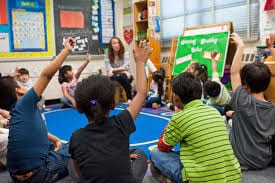Student Contributor: M. Smith
 There are 3 goals of creating rules in the Responsive Classroom approach to discipline. They are 1) establish guidelines and expectations for positive behavior, 2) create a sense of order and safety- both physical and psychological in the classroom, and 3) teach children the purpose of rules by connecting the rules to learning goals.
There are 3 goals of creating rules in the Responsive Classroom approach to discipline. They are 1) establish guidelines and expectations for positive behavior, 2) create a sense of order and safety- both physical and psychological in the classroom, and 3) teach children the purpose of rules by connecting the rules to learning goals.
This approach to the Preventative Phase of classroom management will only be effective in a collaborative student-centered environment. The real purpose here is that the students are brainstorming with each other as the teacher provides suggestions and nudges the group-think along. Using positive phrasing is crucial as we want to be sure to avoid any “Do’s” and “Don’ts.” A sense of community and agreed accountability will be the result of this critical exercise. While establishing these rules, or agreements, keep in mind that they should be few in number and try to steer some of the ideas the students come up with into broader umbrella phrasing to encompass a number of minute concepts. With a shorter list, students will tend to abide easier than if there were a long, drawn-out list. Try to imagine yourself as the Mayor of your small community and this exercise is a town hall meeting where everyone finds common ground and gets on the same page. It sets a nice tone of togetherness and understanding.
 This is primarily a preventative management tool. This occurs within the first day or two of classroom instruction before any academic instruction is shared. In many ways, it serves as an icebreaker for the students to get to know each other more and serves as a formative assessment for the teacher to gauge the culture of the students. By having these classroom rules, or agreements as they should more commonly be referred to, they can be alluded to when needed during both supportive phases and as part of the corrective phase. Should there be need to address corrective measures during class, and the particular behavior is not outlined on the set agreements list, there can be an opportunity for the class to either reword an agreement or make an amendment to the list to be sure that undesirable behaviors are included and accounted for. The Responsive Classroom supports the collaborative student-centered theory of influence and facilitates a strong sense of community and prosocial behaviors and attitudes by keeping open lines of discussion and promoting student accountability.
This is primarily a preventative management tool. This occurs within the first day or two of classroom instruction before any academic instruction is shared. In many ways, it serves as an icebreaker for the students to get to know each other more and serves as a formative assessment for the teacher to gauge the culture of the students. By having these classroom rules, or agreements as they should more commonly be referred to, they can be alluded to when needed during both supportive phases and as part of the corrective phase. Should there be need to address corrective measures during class, and the particular behavior is not outlined on the set agreements list, there can be an opportunity for the class to either reword an agreement or make an amendment to the list to be sure that undesirable behaviors are included and accounted for. The Responsive Classroom supports the collaborative student-centered theory of influence and facilitates a strong sense of community and prosocial behaviors and attitudes by keeping open lines of discussion and promoting student accountability.
More Information –
Tool Source: Brady, K. (2003). Rules in school (Strategies for teachers series). Greenfield, MA: Northeast Foundation for Children.

